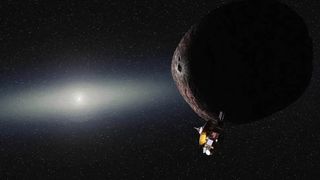Milky Way
Latest about Milky Way

1st image of Milky Way's 'black hole heart' has errors, study claims
By Ben Turner published
The image of Sagittarius A*, the black hole at the heart of the Milky Way, captured by the Event Horizon Telescope.

Euclid telescope reveals 1st section of largest-ever 3D map of the universe — and there's still 99% to go
By Ben Turner published
The first piece of the Euclid space telescope's map of the universe is crammed with 14 million galaxies and 100 million sources of light. The mapping project is now 1% done.

The Milky Way could be part of a much larger 'cosmic neighborhood' than we realized, challenging our understanding of the universe
By Harry Baker published
A probabilistic new map of the universe surrounding the Milky Way reveals that our galaxy is likely part of an even larger "basin of attraction" than we previously assumed.

'We have changed the view of our galaxy forever': Astronomers capture most detailed ever infrared map of the Milky Way
By Ben Turner published
Astronomers at the European Southern Observatory have released the largest infrared map of the Milky Way ever. The enormous dataset contains millions of new objects, and the researchers expect to scour it for discoveries for years to come.

James Webb Telescope goes 'extreme' and spots baby stars at the edge of the Milky Way (image)
By Robert Lea published
The James Webb Space Telescope has taken things to the extreme, studying the outer edge of our own galaxy, the Milky Way and producing a stunning new image.

Biggest black hole jets ever seen are as long as 140 Milky Ways
By Ben Turner published
The largest-ever black hole jets ever seen hint that these cosmic monsters may play an even more significant role in shaping galaxies than previously thought.

The Milky Way's supermassive black hole is spinning incredibly fast and at the wrong angle. Scientists may finally know why.
By Ben Turner published
Observations from the Event Horizon Telescope may reveal a secret merger in our supermassive black hole's past, potentially explaining the cosmic monster's unusual spin.

Space photo of the week: Milky Way's galactic twin captured by Dark Energy Camera
By Jamie Carter published
NGC 6744 is a spiral galaxy bigger than, but otherwise very similar to, our own. NASA has dubbed the large spiral galaxy the Milky Way’s ‘big brother’.
Get the world’s most fascinating discoveries delivered straight to your inbox.




